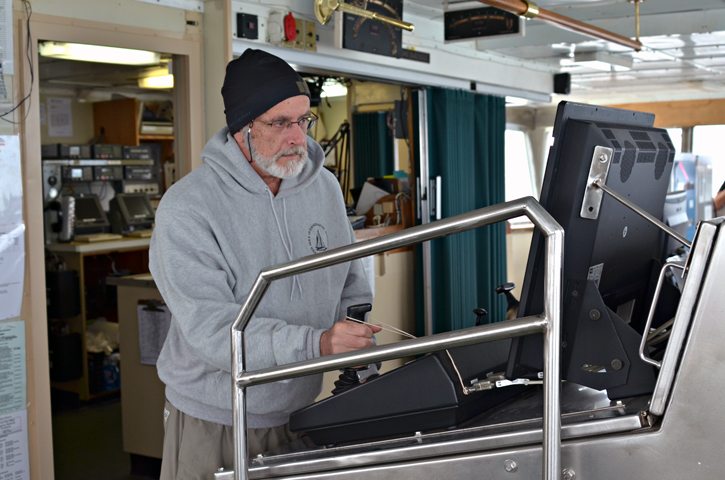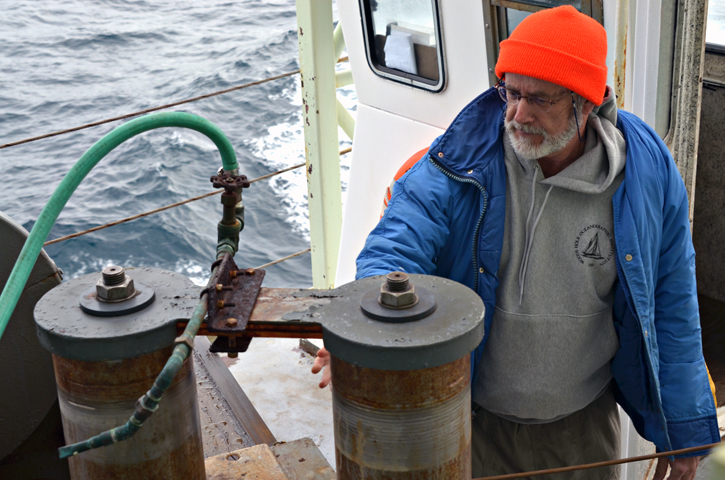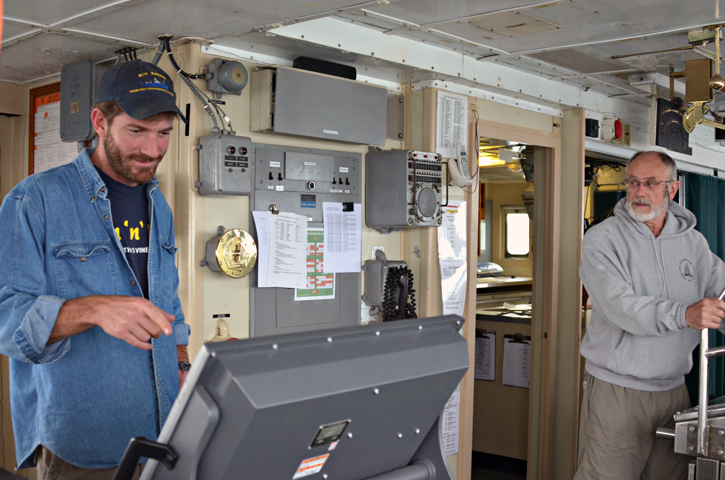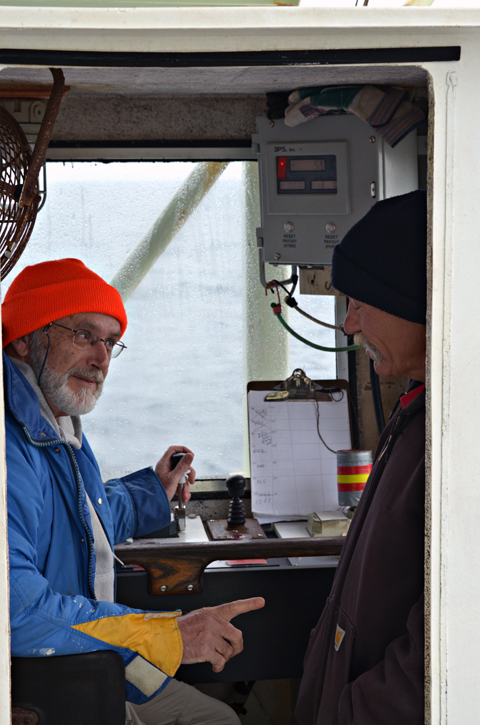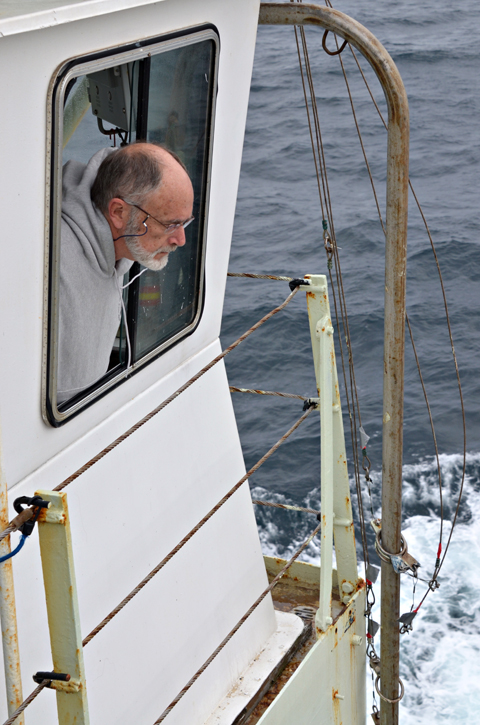September 20, 2011Knorr’s people make things look so easy, one can almost begin to think they are. But I know better, firsthand. Knorr was parked bow into a moderate north wind and flat seas. The 255th CTD cast was complete. “Okay,” said the Skip, “are you ready to put her on the next station” “Well,…sure.”
Learning to drive. © Rachel Fletcher He told me to switch off the Dynamic Positioning (DP) inputs, take manual control and, using the joystick, come right to one-eight-zero. It’s often compared to a video game, this DP system. I twisted the joystick, added some power, and watched the bow swing through 180 degrees. The Skip had walked me through the process last year in the Indian Ocean and earlier this trip, so I knew how to settle her on the new heading, engage the autopilot, and dial in fine-scale changes to her course; but I had never put her on station and held her there during an actual CTD cast. The next position was coming fast. “So how are you going to make the turn?” Yeah, I was wondering about that. I had to stop the ship on the waypoint (WP) with her bow pointing into the wind in the opposite direction. Skip suggested a looping turn to port about two ship lengths off the track to the WP, which appears as a blue line on the screen, go past the WP and swing back into the wind. All of this is visually displayed—a ship-shaped icon actually moving over the screen, leaving a “shadow” to show where she’s been, and another icon indicating the place to stop. “Start bleeding off speed….Now turn her aggressively….About a knot-and-a-half now. Yeah, good.” We were there. The Skip showed me how to engage the controls to keep her there. “Good.” He informed the CTD ladies and Kevin, the winch driver, that we were on station and “hove-to”—which is to say we were no longer moving through the water.
One of the common misconceptions about this fancy gear is that once you’ve told the ship to stay where she is—she will do so within a couple of meters if so instructed—that that’s all there is to it. But we’re putting the CTD package down perhaps 2,000 meters where it can encounter currents different from those on the surface, causing the package to stream away from the hull, called “kiting,” or worse inboard such that the wire abrades against the hull. So my task was to “keep the wire straight” by moving the ship in relation to the wire. I went out on the bridge wing to look at the wire as it went down. Good….No, it was streaming aft. “So what are you going to do?” “Move her…aft.” “Let her settle in to be sure. You don’t want to start chasing the wire.” We watched….”What do you think?” “It’s streaming aft. I’ll give her a little reverse.” “Don’t over do it.” Just a tap of reverse on the joystick—and back out to watch the wire (don’t chase it). “Now let’s talk about the ‘scan’. You don’t want to focus on just one instrument. So what do you scan for?” I ticked off the obvious factors, wind, current, position, wire. Remember, this only seems like a video game, the Skip had cautioned me. This is still a ship. Nautical forces are still going on out there.
Yes. © Rachel Fletcher He pointed to the big radar screen. “Did you talk to this guy?” What? Oh. There was no target on the screen; we were alone. But I got the point. For all I had known, we were about to be t-boned by a supertanker. So it went through the cast, watch the wire, tweak the ship’s position, scan the forces acting on the ship and the package until it’s back aboard. “Good job,” said the Skip. I hope it’s clear that, while I grasped the concept, I could not have executed the maneuvers without coaching. Kevin, who’d been driving the winch called on the “squawk box” to say that the CTD was secured. “Which way are you going to turn for the next station?” “Starboard.” Unlike the port side, the maindeck on starboard is open. That’s where all the work is done. Therefore, whenever possible, the bridge watch turns to starboard from the completed station toward the next, so as not to expose workers to the weather. I disengaged the DP controls and twisted the joystick to the right. We were underway again.
Did you call this guy? © Rachel Fletcher Kevin had come onto the bridge to assume the lookout, and so did Chief Mate Adam, whom the Skip was spelling during dinner. “Dallas has got the con,” said the Skip. That had a pleasing ring to it. If only it were true. “Now, to get the whole CTD experience,” said Adam, “you need to learn to operate the winch. And Kevin’s the best teacher on the boat.” “Well,…sure.” * * * “Don’t hit the bottom,” said my teacher as we crowded into the winch-driver’s hut on the 02 deck. “That’s the first point. Don’t two-block it. That’s the second point.” (I’ll explain the two-block disaster in a minute.) He then explained the general process: You lower the package at 60 meters per minute—here’s the speed indicator—until the operator on the control panel announces 100 meters from the bottom; then you slow the descent to 30 meters. At ten meters from the (crash site), you slow to a crawl until she says, “All stop.” Then you start it back up at 60 until she calls ten meters before the first stop. At each stop, the operator records temperature, salinity, depth and oxygen content, and they “fire” a bottle to capture a water sample. “You do that part.” He didn’t exactly say that any moron could do that part. “I’ll launch and recover it, and you watch for a couple of casts, then you’ll do it. Pay constant attention. That’s the third point. You listen to headphones, read your Kindle—that’s when accidents happen and people get hurt.” I watched Kevin launch and retrieve it—the hard part—while I ran the easy middle part. We paid close attention to the wire-out meter and winch-speed meter while we discussed literature we liked. “Okay,” he said, “are you ready to run the next one?” “Ready.” If not able. Here’s the hard part: The winch lifts the CTD straight up off the deck, the wire running though a big block, or pulley, around a couple of fair-leads to the big winch drum next to our hut. However, when it goes straight up, it’s still over the deck, not the water. To get it over the water, the winch driver has to extend the heavy boom to which the block is shackled. Trouble is, extending the boom also acts to take in wire, thus lifting the CTD toward the block. That’s where the two-block disaster looms. If the driver doesn’t compensate by lowering the package as he extends the boom, then the block at the top of the package frame will be jammed up into the big winch block—two-blocked—and this could break the wire. And a couple of hundred thousand bucks-worth of kit goes to the bottom. “Got it?” “Uh….So as you extend the boom, you’ve got to lower the package at the same time. Both at once.” “Right. And you do the opposite as you retrieve it. You do it next time. I’ll be right here.” To pick up the pieces.
My time unavoidably arrived. I stood around the winch hut with Kev trying to look nonchalant as we came onto station and stopped. Then I took my place in the hut looking down at the CTD and the people unstrapping it from the pallet. Good luck, said Kate and Stine as they did so. That’s when I noticed an audience was gathering. SSSG Catie stood on the 02 deck. Was she smirking? The Skip came on deck to watch. Others materialized on the maindeck. Could I get out of this? When the boom goes out, the package has to go up. No, no, it’s the other way around. Concentrate. The package has to go down when the boom goes out. Down….not up. Up on the retrieval, when the boom comes in. Sorry, Kev, gotta go. Jury duty. Forgot to mention that. I called the bridge for permission to launch, with scant hope that they’d deny it. Up when the…. I put the winch lever forward—thereby unspooling great snakes of wire onto the deck— “Stop!” Kevin squealed. Anton and Catie held the wire taut while Kev re-spooled it. I didn’t turn around, picturing the audience seeking shelter indoors and/or summoning the Damage Control team. “Try it again, only this time lift it first.” I took both levers in sweaty hands, hoisted the package off the deck above the rail height. This was no time to quit smoking. Now, the boom out, the package down to compensate—well, to make an anxious story short, I didn’t make a further hash of it. I got it down and back up without incident or injury, but not much beauty, and thank God for the long steam to the next station. I needed a shower. “So what job are you going to do next?” asked some wag as I walked into the mess deck. “Captain?” Last updated: December 27, 2011 | |||||||||||||||
Copyright ©2007 Woods Hole Oceanographic Institution, All Rights Reserved, Privacy Policy. | |||||||||||||||


